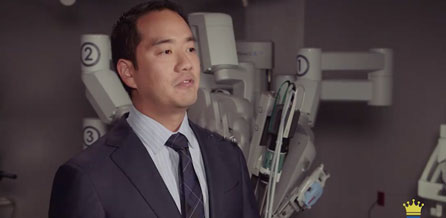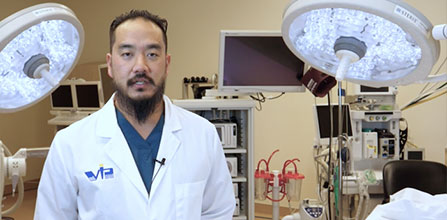Hernia Overview, Causes & Symptoms
A hernia is simply a hole in the strong, protective abdominal sheath known as the fascia – the tissue that holds the abdominal contents in place. When a hole develops, it allows certain abdominal components to push through – this can be fat or organ tissue – often the large intestine / colon. When the abdominal contents push through the hernia, it often causes a visible bulge and some discomfort.
Hernias are a progressive disease, meaning that they do not get better on their own with time. While some sources advocate for a hernia truss or belt, these are very rarely, if ever, effective and can even be dangerous. The only curative solution to a hernia is surgery. Today, the advances in surgical technique and mesh technology has made hernia repair a very safe and effective procedure.
Many people can live for years, decades, or even their whole lives with an asymptomatic hernia. Because the risks of most hernias are relatively low, we do not act actively screen for them. In other words, if they’re not causing symptoms, we don’t look for them. However, hernias tend to get larger over time and, as a result, become more complex to repair.
Causes of Hernias
There are many and varied causes of hernias. Research has shown that some people are genetically predisposed to develop hernias. Some patients have congenital defects in the abdomen that allow for hernia development. Most patients develop hernias because of excessive strain on the abdomen or due to a previous surgical procedure that creates a weak point in the abdominal wall. Obesity, pregnancy, COPD and smoking all increase the risk of developing a hernia.
The best measure for hernia prevention is to remain healthy and at a normal weight, as well as to avoid undue strain on the abdomen. Otherwise, there are no exercises that can prevent a hernia in the future.
The Risks of an Untreated Hernia
Hernia repair is elective surgery in most cases. However, occasionally, it is possible for the contents of the abdomen to become trapped in the hernia. This is known as incarceration or an irreducible hernia. Irreducible hernias typically cause a good amount of discomfort and require an urgent visit to the ER. The real risk comes when an incarcerated hernia becomes strangulated – in other words when the blood supply to the abdominal contents is cut off. This causes very rapid death of the pinched tissue. When the large intestine become strangulated, a simple hernia repair can turn into emergency surgery with the very real possibility of a colon resection if the patient does not present to the emergency room soon enough.
The risk of an untreated hernia also includes the enlargement of the hernia to the point where the repair becomes complicated. Larger hernias require more mesh and the risk of hernia recurrence is higher. Extremely large hernias may also require abdominal reconstruction.
Types of Hernia
The type of hernia is classified based on the location of the hernia in the abdomen as well as the cause. Some hernias are very common while others are quite rare. The most common hernias include:
- Inguinal hernia. This is a hernia in the groin and mostly affects men. Inguinal hernia is caused by abdominal contents pushing through the natural opening in the abdominal fascia accommodating the spermatic cord. Inguinal hernias can be unilateral: on only one side or bilateral: on both sides.
- Femoral hernias are characterized by a bulge in the upper thigh. These hernias affect women more than men and have the highest rates of strangulation. Therefore, any patient that presents with a femoral hernia is referred to surgery immediately.
- Umbilical hernias are those that occur in the umbilicus or bellybutton. We all have a natural weak point in our abdominal facia at the umbilicus due to the umbilical cord. Some cases of umbilical hernia exist from when the patient was a child, while others developed because of abdominal strain or pregnancy.
- Incisional hernias occur at incision points from previous surgeries. When surgeries were performed in an open manner, with a single, large incision, these hernias were relatively common. Now, with the advent of minimally invasive or laparoscopic surgery, we have reduced the occurrence of incisional hernias significantly. However, any perforation of the abdominal wall increases the risk of an incisional hernia.
- Hiatal hernias do not incur in the lower abdomen. Rather, they involve a defect in the diaphragm that allows part of the stomach to push through. The most common symptom includes reflux, but most cases are asymptomatic. Hiatal hernias are very common in the obese population and are often identified and corrected during a primary bariatric procedure.
Symptoms of a Hernia
Hernias may be symptomatic or asymptomatic. Symptomatic hernias usually manifest as bulges or lumps. Small hernias may show no visible bulge. Some patients may feel pain or discomfort in or around the area of the hernia. The discomfort may be dull or sharp or feel like burning or heaviness.
Treatment for a symptomatic hernia is almost always hernia repair surgery.



